Rugbyman
The orthopaedic specialist looked me over and asked if I played rugby when I was younger. I could see the assumptions clicking over behind his eyes: Englishman + big physique + gone to seed = former rugby player.
As it happens, I did play rugby – in my mid-teens for one year under a temporary Welsh sports teacher. As it happens, I found it the most enjoyable and inclusive team game I ever tried. Far superior to football.
“Did you ever break your shoulder?”
No.
“It might have happened without you realising. A crack only. That’s what’s coming back to haunt you!”
Swimming
I’m going through everything I’ve published on this blog over the years. It’s a kind of cataloguing as I prepare for my magazine/portfolio/collection. (The Supercargo’s Magazine: For Your Consideration, forthcoming this side of the summer. Fingers crossed.) Doing this I’ve been surprised at how many pieces – especially in the early days – I wrote about swimming.
There’s poetry, (attempts at) humour, meditations and anecdotes. And then there’s a dearth. It’s not that I stopped swimming – not in the early days. More that I found other subjects to write about. But then I did stop swimming.
That was because my enjoyment was gradually leached out of it by pain.
Pain
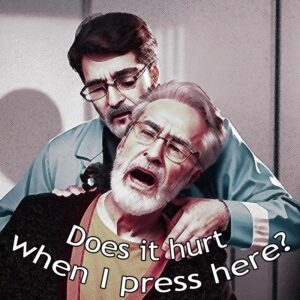
The pain was in my right shoulder. I felt it deep in the joint, but also over the back of the shoulder-blade and down the upper part of my arm. When it first started, I felt it most doing the breast stroke, so I quit that for a few weeks. Maybe I also quit swimming for a time. (There was a period when my local baths were closed for renovations and I was too lazy to take myself across town somewhere else.)
The pain went away.
When the pool opened again I went back to swimming and, after a time, the pain came back.
Same procedure: I suspended the breast stroke. But this time the pain continued. So I cut out the crawl. No help. Finally I gave up on the backstroke. There was a time I was just floating around the pool on my back under leg power, arms trailing in the water. And it still hurt.
So I called my health centre and got redirected to my local physiotherapy clinic and what the Swedes call a sjukgymnast. (Literally a sick gymnast. She may have been that too!) Cool, competent and (to my eyes) young. She felt my shoulder in different positions, put me through a series of tests and decided I’d over-strained the joint.
She gave me exercises to build up the muscles around the joint to take the strain off and I added them to my daily routine. They certainly helped. Now I could use my arm in everyday activities, but I wasn’t tempted to get back in the water. Deep in the joint the pain remained.
Covid
Covid came and the swimming baths closed. Not that I was swimming, but the opportunity was no longer there.
It became hard to see a doctor for any reason. Besides, my shoulder problems didn’t feel serious enough. (People were dying after all.) But the pain continued, so eventually I phoned in and got a time.
When I saw my doctor, we were both hiding behind blue paper face masks and sitting a good distance one another. (If perhaps not the regulation 1.5+ metres. I’m not sure there would have been room in her office for that.) She told me she thought I needed an ultrasound scan, but that I ought to see an orthopaedic specialist. Under Covid, she warned me, she didn’t know when I might get the call.
But the call came after only a couple of weeks.
Namaste
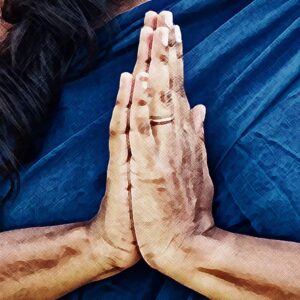
The orthopaedic clinic was down in the city in a new building off one of the tree-lined boulevards. I walked. (I did a lot more walking during Covid.) The city was cheerful in the late spring. Largely car-free, as people were working from home, and friendly in a distant, Scandinavian way.
I think the doctor had been called in from retirement to help out. He wasn’t into blue face masks although he did not try to shake my hand. We performed the Indian greeting, palms pressed together before our chests. He had the aura of a hippie-grown-up, but was dismissive of other medical professionals in the same arrogant conservative way of so many elderly medical specialists.
Of my fysioterapeut (physiotherapist): “Is that what they’re calling themselves nowadays?” (They aren’t, I said. It’s just what I called her not being able to remember sjukgymnast in the moment. He ignored me.)
Of my doctor wanting me to get an ultrasound: “We won’t take what she says very seriously.”
This was when the exchange took place that I started with. Having decided I had an inflammation from an old rugby injury, the specialist was adamant. We won’t send you for an (effete) ultrasound. We’ll send you for a (manly) x-ray.
“In the meantime,” he said. “I may be able to cure all with a magic shot!” And produced a hypodermic with the sleight of hand of a stage magician and an expression that told me he was doing something a little bit naughty.
“Cortisone,” he said, stabbing me in the shoulder-blade and pushing home the plunger.
An impingement
I wanted the cortisone to work so much that I actually felt the pain got less. Except it was all in my mind and the pain was still there two weeks on when I got the X-ray. This was at a medical-technical laboratory in a less salubrious part of town. Long lines of people waiting, blue masks and everyone trying to keep a Volvo’s width between them. (This is Gothenburg, Sweden. Volvo’s home town.)
Back to see the orthopaedic specialist. While the receptionist was checking my appointment, I mentioned that the cortisone hadn’t worked.
Her eyebrows over her blue mask went up. “Cortisone?”
It seemed the specialist had been flying under the radar, giving me that jab. He’d also not written it up in my journal.
When he saw me, after we’d done the namaste greeting, he was a bit brusque. I think someone had told him off for not reporting the cortisone shot. He identified me as “The shoulder break.”
Except I wasn’t. I didn’t have a shoulder break. I’d thought to ask the X-ray technician and he said he couldn’t see any sign of a break in my shoulder blade. I said as much.
Oh dear. My specialist was very unhappy. Apparently the technician should never have told me anything about what he thought he could see in the x-ray. That was definitely not his job, and I shouldn’t have asked. Eventually, the specialist deigned to look at the x-ray image himself and, no, he couldn’t see a break either.
“I suppose I’ll have to send you for an ultrasound after all.”
Another fortnight. Another visit to the tech lab, a different technician, a different procedure.
You’ll never swim again
The specialist was getting tired of me by now.
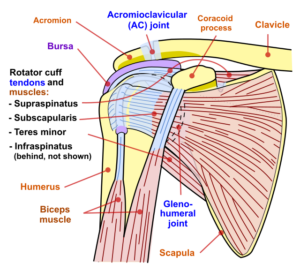
“So what you have is rotatorcuff tendinit. An impingement,” he said on my third visit. He took out model of an articulated shoulder and explained with much Latin and some English larding his Swedish. I came away with the idea that the bone of my shoulder joint had bulked up, narrowing the socket where my arm turned.
There was nothing to be done, other than an operation to grind down the bone to make the space wider.
“That’s disappointing.”
“What were you hoping for?”
“I was hoping I’d be able to get back to swimming.”
“Oh, you’ll never swim again.”
Booking myself for a grinding seemed like an extravagance under the circumstances, and also likely to make things worse. So I carried on as before. Did a lot of walking, did my exercises. Eventually the vaccines came along and the Covid scare abated.
I was doing some thinking. If the joint was inflamed the muscles and tendons would be swollen, wouldn’t they? And if swollen, the space in the rotator cuff would be even smaller. So the swelling might be making things worse. Might even be self-perpetuating. What if I could get the swelling down? Might that ease things up?
Perhaps a cortisone injection in the right place?
My doctor was very reluctant. I think there must have been a spate of people using cortisone excessively and for minor injuries. I think doctors have been told not to use it. However my doctor heard me out, agreed I wasn’t completely wrong, but warned me there was only a 50-50 chance the cortisone would work. I said I’d take those odds.
It worked!
It worked. Not immediately, but over about a week, the pain I’d been living with for more than two and a half years, just faded away.
I was very careful for a longer time after; so scared the relief would only be temporary. I cautiously trying out various things and kept up my arm exercises. It took me months to dare to get back into the water.
However, since January I have been back and swimming a couple of times each week. Very cautiously, not pushing myself. I’ve built back up to the same 40 lengths (1km) I was managing before the impingement. I’m hyper aware of the creaking in my shoulder joint and of any pains I get. I cut down the effort immediately, and stop swimming completely if I feel the old pain coming back. I take paracetamol until the pain goes.
(And now, just writing about this I can feel the pain again in my shoulder. That is psychosomatic! I hope.)
Maybe it won’t work in the longer term. Maybe I’ll need to get surgery after all. But for now I’m just pleased to be swimming again.
Note
The illustrations here are a mixed bunch. The diagram of the human shoulder joint comes un-edited from Wikimedia Commons here. The hands performing the nameste greetings come originally from Wikimedia Commons here, but then I processed in Photoshop. The “Does it hurt when I press here?” image started life as a still from an episode of the original Star Trek series. Mr Spock is performing the Vulcan nerve pinch on a screaming man. (Found on a Pinterest site here.) I passed it through the AI Dezgo/Stable Diffusion AI image-2-image generator (here). And then through Photoshop on my own computer.

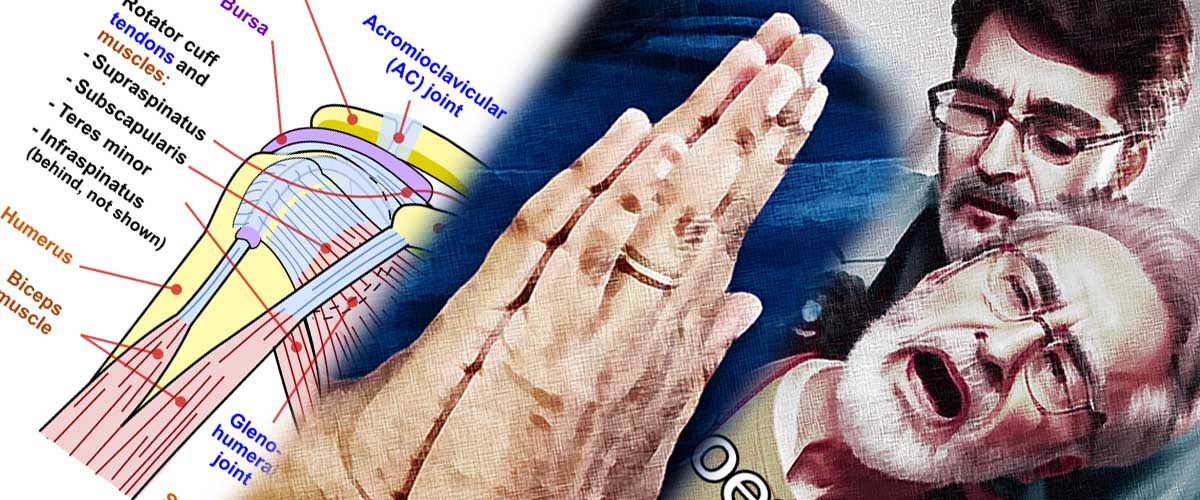
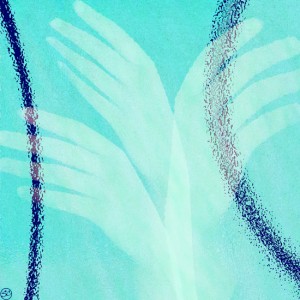
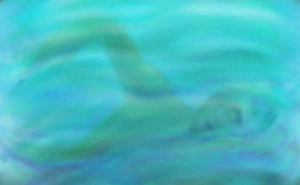
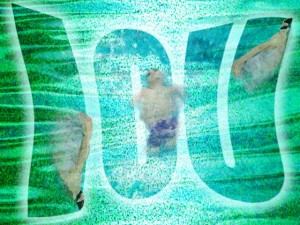
What a great chronic(pain)le to read!
Doctors saying “you will never do X again”… They have 50/50 chance of having that right….
I swim as well, I am looking forward te read the swimming posts!
I am so very happy to be able to swim again! 🙂